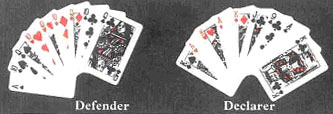JO-JOTTE
ALTHOUGH Jo-jotte was invented by Ely Culbertson in 1937, it is not altogether a modern game, but a variation of the old French game of Belotte, in itself very similar to Klaberjass and its several variations.
NUMBER OF PLAYERS
Jo-jotte is a game for two players.
CARDS
Jo-jotte is played with the short pack, namely a pack from which all cards below the rank of 7 have been removed.
The rank of the cards varies. If there is a trump suit, the cards of the suit rank in the order: Jack, 9, ace, 10, King, Queen, 8, 7. In plain suits, or if the hand is played in no-trumps, the order is: Ace, 10, King, Queen, Jack, 9, 8,7.
Each player is dealt six cards (either singly, or in twos or threes) and the 13th card of the pack is placed face upwards on the poker table. This is known as the turned card.
BIDDING
There are two rounds of bidding. The non-dealer bids first. He may either accept the suit of the turned card as trumps, or pass. If he passes, the dealer has the same option. If both players pass, the non-dealer may name any suit, other than that of the turned card, as trumps, or he may declare no-trumps or he may pass.
If he passes for the second time, the dealer has the same option. If both players pass twice the hand is abandoned and the deal passes, but if either player names a suit as trumps, his opponent may overbid it by declaring no-trumps, but not by naming another suit as trumps. Either player may double his opponent’s declaration, and any double may be redoubled.
THE PLAY
When the declaration has been determined (doubled, redoubled or passed) the dealer deals three more poker cards to his opponent and to himself, and he places the bottom card of the pack face upwards on top of the undealt cards of the pack. It has no significance in play but is solely informatory and, therefore, is known as the information card.
The player who has made the final declaration is known as the declarer: his opponent as the defender.


At this stage of the game the defender may announce that instead of defending against the declarer’s contract he will himself become declare at a nullo contract; a contract, that is, to lose every trick. the declarer may now declare a slam, contract to win every trick either in the suit originally named by him (he cannot change the suit) or in no-trumps.
The defender then announces his melds, if he holds any. A meld is four of a kind (except 9s, 8s, and 7s at no-trumps, and 8s and 7s in a suit declaration). A meld carries a score of 100 points and is scored (as at Bridge) above the line. Only the player with the highest card ranking meld may score for it, and he may score for a second meld if he holds one.
Next, beginning with the defender, the players score for sequences, and for this purpose the cards take their normal rank of Ace (high), King, Queen, Jack, 10, 9, 8.7. For a sequence of five cards the holder scores 50 points above the line, for a sequence of four 40 points, and for a sequence of three 20 points.
If two sequences are of equal length, that headed by the highest card takes precedence. If both sequences are equal, a sequence in the trump suit wins over one in a plain suit; if both sequences are in plain suits neither is scored for. Only the player with the higher-ranking sequence may score for it, and he may score for any other sequences that he may hold.
In the top illustration below, clubs are trumps. Defender scores 200 points above the line for his melds of 10s and Queens, and the declarer cannot score for his meld of Kings because in the trump suit the 10 is higher than the King.
